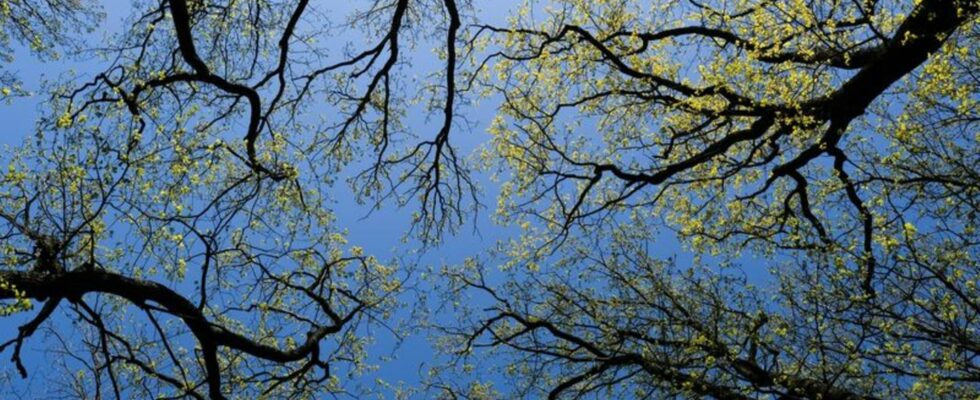forestry
Özdemir: “One in five trees is healthy”
Forest covers around a third of Germany’s entire area. photo
© Jens Kalaene/dpa-Zentralbild/dpa
If oaks, beeches or spruces are sick, you can also tell from the treetops. There are now new official assessments on this.
Drought, heat, damage from beetles: German forests continue to be under high climate stress. Of the most common species, spruce, pine, beech and oak, four out of five trees are diseased, according to a survey by the Federal Ministry of Agriculture for 2023. “The forest is becoming a long-term patient,” said the department head Cem Özdemir (Greens) in Berlin. “A long-term cure” is necessary in order to create more mixed forests. Environmental associations and forest owners are also pushing for a conversion to more resilient forests.
The forests have been “massively affected by the climate crisis,” said Özdemir. Even though there has recently been more rain over the winter, the trend remains: “Our German forests are not doing well.” Many trees are still weakened by dry years since 2018. Healthy forests are urgently needed – also as an “air conditioning system” when trees bind carbon in the wood, said the minister. In addition, forests with their animals, ferns and mosses are havens of biodiversity, places for walks and peace – and workplaces for many people. Forests cover around a third of Germany’s entire area.
Tree damage remains at a high level
“Overall, the damage remains at a very high level,” says the new survey for 2023. Compared to 2022, there were “no significant improvements in the condition of the forest, but also no significant deterioration.” Since 1984, the annual examination has been carried out by the federal states via a network of samples. From mid-July to mid-August, the leaf mass of the crowns is assessed and assigned to four “damage levels”. This time there were 9688 trees at 402 points. The federally owned Thünen Institute then extrapolates the data to produce a Germany-wide result.
How dense the leaves or needles are is an indicator of health. And the new findings showed little change. Last year, 36 percent of the trees across all species had “significant” damage – after 35 percent in 2022. Compared to healthy trees, more than a quarter of their crowns were already bare. 44 percent of the trees still belonged to the “warning level” with weak crown thinning of 11 to 25 percent. 20 percent still had full crowns, down from 21 percent previously.
Only slight improvement in pine trees
“Our older trees over 60 years of age are particularly affected by damage, but there is also a negative trend among younger trees,” says the survey. There are four main species in particular, which together make up three quarters of all trees. Slight improvements were only found in pine trees – the proportion with significant damage fell from 28 percent to 24 percent. For spruce it rose by three percentage points to 43 percent, for beech by one point to 46 percent and for oak by four percentage points to 44 percent.
Özdemir made it clear that making the forest better prepared for climate change is a generational project – and forest owners should not be left alone in this “mammoth task”. This year, 250 million euros in funding are planned.
In general, the main aim is to transform monocultures into mixed forests and thus reduce risks. They are more stable and less vulnerable, explained expert Nicole Wellbrock from the Thünen Institute. Among other things, the nutrient supply in the soil can be better used through different root depths. In monocultures, bark beetles could quickly eat through.
Freedom or more requirements for foresters?
Özdemir is also preparing a reform of the almost 50-year-old Federal Forest Act, which should combine more climate protection with economic prospects for forest owners. FDP parliamentary group deputy Carina Konrad told the German Press Agency that the forest is a patient that urgently needs help. “Leaving him to his own devices would be a failure to help.” To achieve this, it is important to give forest farmers more freedom. A resilient forest must also integrate non-native tree species, because not all native ones can withstand increasing extreme weather conditions.
Environmental organizations called for a change. The WWF complained that the central reason for the misery was that for decades the forest had been seen primarily as a quick supplier of wood. Greenpeace said Özdemir had a historic opportunity to convert the existing “deforestation law” into a “forest protection law.” The Nature Conservation Association called for “contemporary guidelines,” for example for a ban on clear-cutting and a ban on drainage. The association of forest owners explained that the legal conditions were not the cause of the damage, but rather climate change. There is no need for additional regulation that would paralyze the necessary forest conversion.
According to calculations by the German Weather Service, the temperature in Germany has risen by 1.6 degrees since the pre-industrial period around 1880. The five warmest years since then were after the year 2000. The temperatures in this country have risen significantly more than the global average (around 1.2 degrees).

